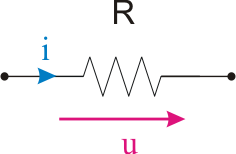A resistance is a dipole that converts all the electrical energy absorbed, in thermal energy. The resistance represents the physical characteristic of all materials to oppose themselves to the flow of electrical current; the materials that are good conductors have little resistance and the insulating materials have high resistance.
The resistance of a conductor depends on the resistivity  of the material from which it is made of, on the conductor's section S and on its length
of the material from which it is made of, on the conductor's section S and on its length  :
:

The symbol of a resistance and the reference directions of the voltage and of the current (the convention for the receiver) are:

Figure 7 - Symbolic representation of the resistance and the reference directions
The value R of the resistance is expressed in ohm(s) (  ) and, considering the previous expression, is positive.
) and, considering the previous expression, is positive.
The characteristical equation of a resistance is:

The power at its terminals, characterized by the Joule effect of the current, can be written:

Considering that  and also
and also  can only have positive values and taking into account the fact that positive directions for the convention as load have been used, it results that the power
can only have positive values and taking into account the fact that positive directions for the convention as load have been used, it results that the power  is always absorbed by a resistance.
is always absorbed by a resistance.
We can define the conductance G associated to a resistance R, as being:

The conductance G is expressed in siemens (  ).
).
The characteristic equation of a conductance is:
 ,
,
the power at its terminals being:

Similarly to the resistance, a conductance absorbs energy.